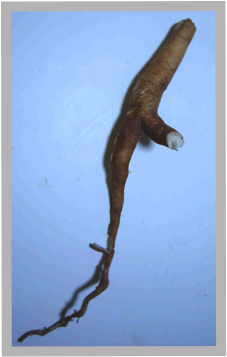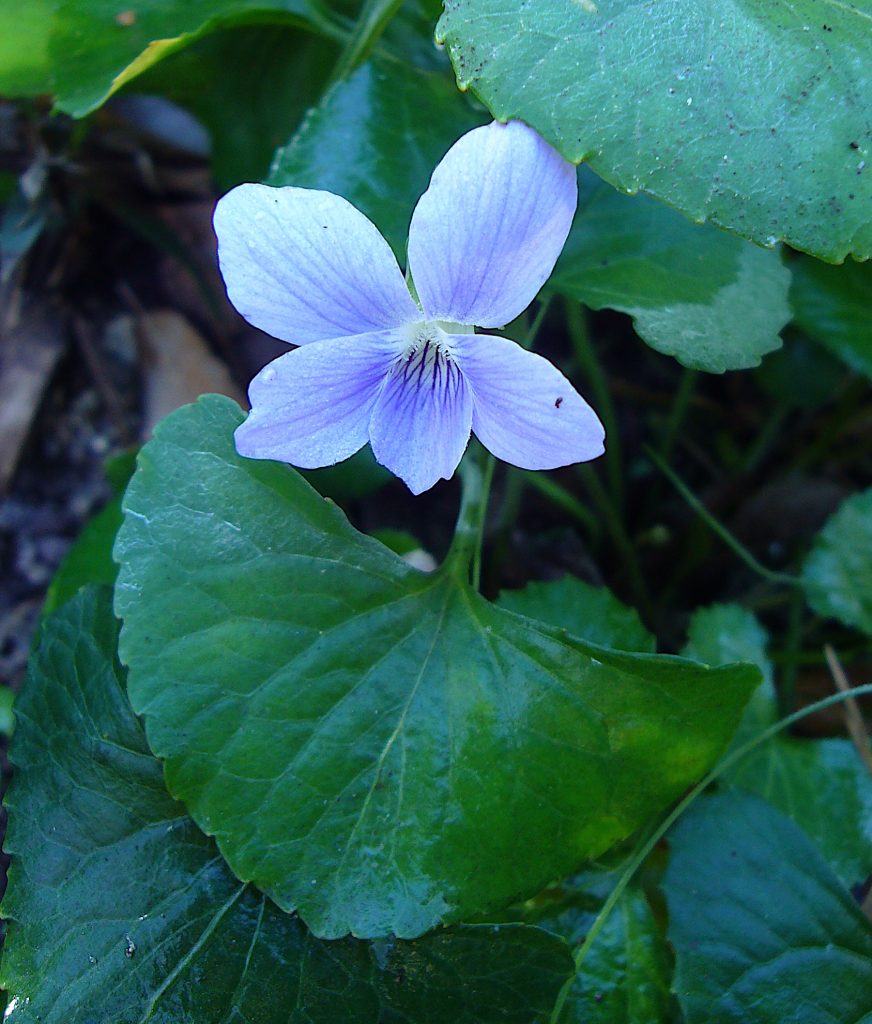
Wood Violet Photo by Green Deane
A common blossom that’s easy to identify is the violet. It’s cultivated brethren is the pansy. There are a huge variety of violets in North America ranging from field pansies to those that like to grow down hill from the septic tank. Whether wild or cultivated violets are attractive, personable blossoms, usually on the sweet, viscous side. There are a couple of precautions, however. The first is to make sure the soil they are in — either a pot or bed — is wholesome and that the water they are getting is good. If they come from a garden center they might have pesticides on them. The other precaution is a bit more esoteric: Yellow blossoms tend to have a laxative effect. Also notice the leave are somewhat heart shaped, NOT a triangle. You can read about violets here. I have a video about them here.
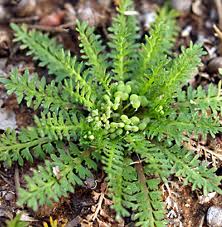
Swinecress is an easy to identify winter mustard. Photo by Green Deane.
During a class seasonal mustards were also on display. Poor Man’s Pepper Grass is everywhere. Hairy Bittercress was found nearby as was Swine Cress (article here, new video here.) Also well-represented this past week was Shepherd’s Purse, Capsella bursa-pastoris, a much milder relative of Poor Man’s Pepper Grass. They have similar blossoms but differently shaped leaves and seed pods. The Shepherd’s pods look more like hearts than “purses.” One interesting aspect about Shepherd’s Purse is that I personally have never seen it growing south of the Ocala area. It’s found in 18 northern counties of Florida, one west central Florida county, Hillsborough, one southern Florida county, Dade, and throughout North America. It’s just kind of sparse in the lower half of the state. Also not see yet this season is Western Tansy Mustard. You find it in dry, sandy places like
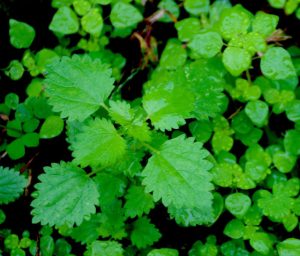
Stinging Nettles are making their seasonal debut. Photo by Green Deane
Our mighty stinging nettles are up. They’re one of the most popular wild edibles.The most powerful stinging nettle is in New Zealand (Urtica ferox) which kills animals and has claimed at least one human life. Our nettle, Urtica chamaedryoides, has a sting like a giant wasp and can burn for days or more. While its common name is a deceptive, “Heartleaf Nettle” its botanical gets to the point, “Stinging Dwarf.” Quite edible but you must handle it with care. If this particular species stings me it is not only extremely painful but a welt develops and the site is sensitive to temperature changes and any liquid for more than a week. The irritant compounds are histamines and acetocholines. Apparently I am quite sensitive to them though I can eat the plant raw or cooked (crushing the needles disarms them.) Also don’t confuse this plant with another stinging plant called the Spurge Nettle, Cnidoscolus stimulosus (video here ). That has an edible root but the leaves are usually not eaten. To learn more about the Heartleaf Nettle go here. For a video, here.
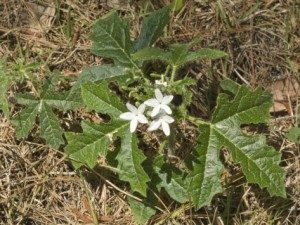
The purge Nettle is well armed. Photo by Green Deane
Don’t confuse the stringing nettle with the spurge nettle.The sting of the Cnidoscolus stimulosus, or spurge nettle, is more like a sun burn than a sting. The area it touches gets hot for about an hour, not unbearably so, and then it goes away. If there is a saving grace to its sting, in comparison, it is that the sting isn’t too bad and goes away rather quickly. The stinging nettles (Urtica) are seasonal, the spurge nettle (Cnidoscolus) is nearly year-round. It is not quite the problem plant that the Urticas are, but that is a matter of debate and opinion.
A young mother wrote to me asking how to get rid of the spurge nettle. She said she had a couple of acres and the plants were all over the place, bothering her children and her dog. I wrote back and said “lucky you. The roots are quite delicious, eat them.” She replied saying that I just did not understand her. She wasn’t interested in eating them; She wants to get rid of them. I told her that I had two good students living very near her who would love to visit her property on a regular basis and dig them up. I added that she could mow the area constantly and in a few years the roots will become exhausted and the plants will die off.
The exchange led me to wonder what was missing? Or better still, what is, as they used to say, the operant factor? That factor is for most people food comes from a store. Said another way food just does not come out of the ground in your suburban back yard. Even gardeners are viewed as a throwback and a tad eccentric. Here is someone who has a replenishing pantry of a staple crop that must be gotten rid of. Those spurge nettle roots easily could represent hundreds of pounds of wholesome, tasty, starch-based food most of the year that does not have to be purchased or stored. Perhaps it is time to consider a different approach: Train the dog and kids to stay away from the plants, kind of have your plants and eat them, too? To read about the spurge nettle go here.

Foraging classes are held rain, shine, hot or cold. Photo by Nermina Krenata
Foraging classes span mid-state this weekend, from the west coast to tidal water on the east coast.
Saturday January 14th, Eagle Park Lake, 1800 Keene Road, Largo, FL 33771. 9 a.m. Meet at the pavilion near the dog park.
Sunday January 15th the Princess Place Preserve, 2500 Princess Place Rd, Palm Coast, FL 32137, 9 a.m. Meet at the parking lot in the middle.
Saturday January 21th, Bayshore Live Oak Park, Bayshore Drive. Port Charlotte, 9 a.m. meet at the parking lot at Bayshore and Ganyard street.
Sunday January 22nd, Red Bug Slough, 5200 S. Beneva Road, Sarasota. 9 a.m. Meet at the playground.
For more information, to pre-pay or sign up go here.
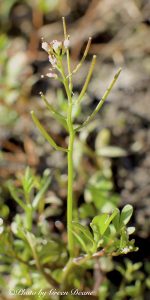
Hairy Bitter Cress hays “tooth pick” seed pods.
Weed Seeds: You can plant many weed seeds to get a crop of edible weeds closer to home, if not in your own yard (now you know why my putting-green neighbors loathe me.) Weeds are designed to take care of themselves and do quite well even when ignored. I have planted wild radish, peppergrass, chickeweed, purslane and crowsfoot grass on my “lawn” and they have done quite well. Many weeds can be planted in your garden. Chinopodiums and amaranth are two that need very little encouraging. Make them a row, barely cover the seeds with soil and you will have a mess o’ greens. Mustards are a bit pickier to grow. Their seeds, such as peppergrass, should be stored in a dry area for about four months between 50 and 68 degrees F for optimum germination. A cellar stairs is just about perfect for that, or outdoors in a Florida winter. Other seeds need special treatment.
My nine-DVD set of 135 videos has been phased out and replaced by 171-videos on a 128-GB USB, see right. The USB videos are the same videos I have on You Tube. Some people like to have their own copy especially if social order falters. The USB videos have to be copied to your computer to play. If you want to order the USB go to the DVD/USB order button on the top right of this page or click here. That will take you to an order form. Or you can make a $99 donation, which tells me it is for the USB (include a snail-mail address.) I’d like to thank all of you who ordered the DVD set over the years which required me to burn over 5,000 DVDs individually. I had to stop making them as few programs now will read the ISO files to copy them. Burning a set also took about three hours.

Green Deane Forum
Want to identify a plant? Perhaps you’re looking for a foraging reference? You might have a UFO, an Unidentified Flowering Object, you want identified. On the Green Deane Forum we — including Green Deane and others from around the world — chat about foraging all year. And it’s not just about warm-weather plants or just North American flora. Many nations share common weeds so there’s a lot to talk about. There’s also more than weeds. The reference section has information for foraging around the world. There are also articles on food preservation, and forgotten skills from making bows to fermenting food. Recent topics include: Stale Bread and Cod Liver Oil, Killing Bugs with Tobacco Plugs, Eating weeds: Is it safe? Have they mutated? Not the Eastern Red Bug but the Pink Tabebuia, African Tulip Tree, Asparagus densiflorus, Green Deane’s Book… You can join the forum by clicking on the button on the upper right hand side of this page.
This is my weekly newsletter #539. If you want to subscribe to this free newsletter you can find the sign-up form in the menu at the top of the page. My website, EatTheWeeds.com, which is data secure, has over 1500 plants on it in some 428 articles. I wrote every one myself, no cut and paste.
To donate to the Green Deane Newsletter click here.

